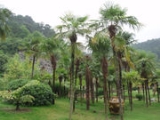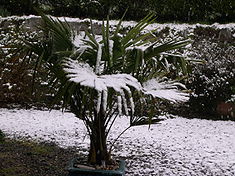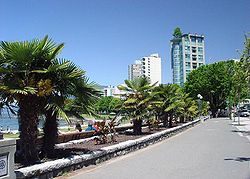
Trachycarpus fortunei
Encyclopedia

China
Chinese civilization may refer to:* China for more general discussion of the country.* Chinese culture* Greater China, the transnational community of ethnic Chinese.* History of China* Sinosphere, the area historically affected by Chinese culture...
(Hubei
Hubei
' Hupeh) is a province in Central China. The name of the province means "north of the lake", referring to its position north of Lake Dongting...
southwards), south to northern Burma. It is a fan palm
Fan palm
Fan palm as a descriptive term can refer to any of several different kinds of palms in various genera with leaves that are palmately compound...
(Arecaceae
Arecaceae
Arecaceae or Palmae , are a family of flowering plants, the only family in the monocot order Arecales. There are roughly 202 currently known genera with around 2600 species, most of which are restricted to tropical, subtropical, and warm temperate climates...
subfamily oryphoideae; tribe Livistoneae, subtribe Rhapidinae).
Description
Trachycarpus fortunei grows to 15 metres (49.2 ft) tall on a single stem up to 20–35 cm diameter. The trunk is very rough with the persistent leaf bases clasping the stem as layers of coarse fibrous material. It is a fan palmFan palm
Fan palm as a descriptive term can refer to any of several different kinds of palms in various genera with leaves that are palmately compound...
with the leaves
Leaf
A leaf is an organ of a vascular plant, as defined in botanical terms, and in particular in plant morphology. Foliage is a mass noun that refers to leaves as a feature of plants....
with the long petiole bare except for two rows of small spines, terminating in a rounded fan of numerous leaflets; each leaf is 140–190 cm long, with the petiole 60–100 cm long, and the leaflets up to 90 cm long. It is a somewhat variable plant, especially as regards its general appearance and some specimens are to be seen with leaf segments having straight and others having drooping tips.
The flower
Flower
A flower, sometimes known as a bloom or blossom, is the reproductive structure found in flowering plants . The biological function of a flower is to effect reproduction, usually by providing a mechanism for the union of sperm with eggs...
s are yellow (male) and greenish (female), about 2–4 mm across, borne in large branched panicles up to 1 m long in spring; it is dioecious
Plant sexuality
Plant sexuality covers the wide variety of sexual reproduction systems found across the plant kingdom. This article describes morphological aspects of sexual reproduction of plants....
, with male and female flowers produced on separate trees. The fruit
Fruit
In broad terms, a fruit is a structure of a plant that contains its seeds.The term has different meanings dependent on context. In non-technical usage, such as food preparation, fruit normally means the fleshy seed-associated structures of certain plants that are sweet and edible in the raw state,...
is a yellow to blue-black, reniform (kidney-shaped) drupe
Drupe
In botany, a drupe is a fruit in which an outer fleshy part surrounds a shell of hardened endocarp with a seed inside. These fruits develop from a single carpel, and mostly from flowers with superior ovaries...
10–12 mm long, ripening in mid autumn.
Occasionally it occurs that a male plant of T. fortunei besides the usual spadices produces also a few other spadices which carry really hermaphroditic flowers. The hermaphroditic and completely fertile flowers are almost exactly like the male flowers, but are a little larger and with the carpels well evolute, the latter about as long as the filaments, furnished with a ring of silvery hairs all round.
Distribution
Although not the northernmost naturally occurring palm in the world (Chamaerops humilisChamaerops
Chamaerops is a genus of flowering plants in the family Arecaceae , comprising a single species Chamaerops humilis , representative of the Pre-Pliocene paleo-tropical ancestral lineages in the area.-Distribution:It is the only palm species native to continental Europe...
grows further north in the Mediterranean region, and Rhapidophyllum
Needle Palm
Rhapidophyllum hystrix is a palm, the sole member of the genus Rhapidophyllum. It is native to the southeastern United States, from central Florida to Georgia, Mississippi, South Carolina and Alabama...
and some Sabal
Sabal
Sabal is a genus of New World palms, many of the species being known as palmetto. They are fan palms , with the leaves with a bare petiole terminating in a rounded fan of numerous leaflets; in some of the species, the leaflets are joined for up to half of their length...
species further north on the Atlantic coast of North America
North America
North America is a continent wholly within the Northern Hemisphere and almost wholly within the Western Hemisphere. It is also considered a northern subcontinent of the Americas...
), it is one of the hardiest
Hardy palms
Hardy palms are any of the species of palm that are able to withstand colder temperatures and thrive in places not typically considered in the natural range for palms. Several are native to higher elevations in Asia and can tolerate hard freezes with little or no damage...
, as it grows at much higher altitudes, up to 2,400 m in the mountains of southern China. This brings it into a climate
Climate
Climate encompasses the statistics of temperature, humidity, atmospheric pressure, wind, rainfall, atmospheric particle count and other meteorological elemental measurements in a given region over long periods...
not only with cold winters, but also cool, moist summers; while Rhapidophyllum may possibly tolerate slightly lower temperatures in winter, it needs much greater summer heat to grow successfully.

Uses
Trachycarpus fortunei has been cultivated in China and JapanJapan
Japan is an island nation in East Asia. Located in the Pacific Ocean, it lies to the east of the Sea of Japan, China, North Korea, South Korea and Russia, stretching from the Sea of Okhotsk in the north to the East China Sea and Taiwan in the south...
for thousands of years, grown for its coarse but very strong leaf sheath fibre, used for making rope
Rope
A rope is a length of fibres, twisted or braided together to improve strength for pulling and connecting. It has tensile strength but is too flexible to provide compressive strength...
s, sacks, and other coarse cloth where great strength is important. The extent of this cultivation means that the exact natural range of the species is uncertain.
Cultivation
Trachycarpus fortunei is cultivated as an ornamental plantOrnamental plant
Ornamental plants are plants that are grown for decorative purposes in gardens and landscape design projects, as house plants, for cut flowers and specimen display...
for use in garden
Garden
A garden is a planned space, usually outdoors, set aside for the display, cultivation, and enjoyment of plants and other forms of nature. The garden can incorporate both natural and man-made materials. The most common form today is known as a residential garden, but the term garden has...
s and park
Park
A park is a protected area, in its natural or semi-natural state, or planted, and set aside for human recreation and enjoyment, or for the protection of wildlife or natural habitats. It may consist of rocks, soil, water, flora and fauna and grass areas. Many parks are legally protected by...
s. Its tolerance of cool summers and cold winters makes it highly valued by palm enthusiasts, landscape designers, and gardeners. The palm can be cultivated the furthest north in the world, being grown successfully in such cool and damp but relatively winter-mild locales as Scotland
Scotland
Scotland is a country that is part of the United Kingdom. Occupying the northern third of the island of Great Britain, it shares a border with England to the south and is bounded by the North Sea to the east, the Atlantic Ocean to the north and west, and the North Channel and Irish Sea to the...
and the panhandle of Alaska
Alaska
Alaska is the largest state in the United States by area. It is situated in the northwest extremity of the North American continent, with Canada to the east, the Arctic Ocean to the north, and the Pacific Ocean to the west and south, with Russia further west across the Bering Strait...
. It is commonly grown in gardens in the United Kingdom
United Kingdom
The United Kingdom of Great Britain and Northern IrelandIn the United Kingdom and Dependencies, other languages have been officially recognised as legitimate autochthonous languages under the European Charter for Regional or Minority Languages...
, Ireland
Ireland
Ireland is an island to the northwest of continental Europe. It is the third-largest island in Europe and the twentieth-largest island on Earth...
, Germany
Germany
Germany , officially the Federal Republic of Germany , is a federal parliamentary republic in Europe. The country consists of 16 states while the capital and largest city is Berlin. Germany covers an area of 357,021 km2 and has a largely temperate seasonal climate...
, Netherlands
Netherlands
The Netherlands is a constituent country of the Kingdom of the Netherlands, located mainly in North-West Europe and with several islands in the Caribbean. Mainland Netherlands borders the North Sea to the north and west, Belgium to the south, and Germany to the east, and shares maritime borders...
, Belgium
Belgium
Belgium , officially the Kingdom of Belgium, is a federal state in Western Europe. It is a founding member of the European Union and hosts the EU's headquarters, and those of several other major international organisations such as NATO.Belgium is also a member of, or affiliated to, many...
, Denmark
Denmark
Denmark is a Scandinavian country in Northern Europe. The countries of Denmark and Greenland, as well as the Faroe Islands, constitute the Kingdom of Denmark . It is the southernmost of the Nordic countries, southwest of Sweden and south of Norway, and bordered to the south by Germany. Denmark...
, the Southeastern
Southeastern United States
The Southeastern United States, colloquially referred to as the Southeast, is the eastern portion of the Southern United States. It is one of the most populous regions in the United States of America....
and Pacific Northwest
Pacific Northwest
The Pacific Northwest is a region in northwestern North America, bounded by the Pacific Ocean to the west and, loosely, by the Rocky Mountains on the east. Definitions of the region vary and there is no commonly agreed upon boundary, even among Pacific Northwesterners. A common concept of the...
ern United States
United States
The United States of America is a federal constitutional republic comprising fifty states and a federal district...
and California
California
California is a state located on the West Coast of the United States. It is by far the most populous U.S. state, and the third-largest by land area...
, coastal regions of British Columbia
British Columbia
British Columbia is the westernmost of Canada's provinces and is known for its natural beauty, as reflected in its Latin motto, Splendor sine occasu . Its name was chosen by Queen Victoria in 1858...
, as well as extreme southern hemisphere
Southern Hemisphere
The Southern Hemisphere is the part of Earth that lies south of the equator. The word hemisphere literally means 'half ball' or "half sphere"...
locations, such as Tasmania
Tasmania
Tasmania is an Australian island and state. It is south of the continent, separated by Bass Strait. The state includes the island of Tasmania—the 26th largest island in the world—and the surrounding islands. The state has a population of 507,626 , of whom almost half reside in the greater Hobart...
.
It does not however grow well in hot climates. The greatest reported cold tolerance is −27.5 °C (−17.5 °F), survived by four specimens planted in Plovdiv
Plovdiv
Plovdiv is the second-largest city in Bulgaria after Sofia with a population of 338,153 inhabitants according to Census 2011. Plovdiv's history spans some 6,000 years, with traces of a Neolithic settlement dating to roughly 4000 BC; it is one of the oldest cities in Europe...
, Bulgaria
Bulgaria
Bulgaria , officially the Republic of Bulgaria , is a parliamentary democracy within a unitary constitutional republic in Southeast Europe. The country borders Romania to the north, Serbia and Macedonia to the west, Greece and Turkey to the south, as well as the Black Sea to the east...
during a severe cold spell on 6 January 1993 and placing it hardy to USDA Zone 7
Hardiness zone
A hardiness zone is a geographically defined area in which a specific category of plant life is capable of growing, as defined by climatic conditions, including its ability to withstand the minimum temperatures of the zone...
; more commonly lower tolerance limits of −15 °C to −20 °C (5 °F to −4 °F) are cited for mature plants. Young plants are less hardy, and can be damaged by only −8 °C (17.6 °F).
The Windmill Palm is very tolerant of wind and salt; it doesn't necessarily need protection from winds or shoreline conditions such as salt. But, protecting any plants in any harsh weather condition is important, and the windmill palm tree is no exception.
Taxonomy
The Trachycarpus fortunei palm was brought from Japan (DejimaDejima
was a small fan-shaped artificial island built in the bay of Nagasaki in 1634. This island, which was formed by digging a canal through a small peninsula, remained as the single place of direct trade and exchange between Japan and the outside world during the Edo period. Dejima was built to...
) to Europe by the German physician Philipp Franz von Siebold
Philipp Franz von Siebold
Philipp Franz Balthasar von Siebold was a German physician and traveller. He was the first European to teach Western medicine in Japan...
in 1830. The common name refers to Chusan Island (now Zhoushan Island
Zhoushan Island
Zhoushan Island is the principal island of the namesake archipelago Zhoushan Islands, governed by Zhoushan City, Zhejiang Province, the People's Republic of China. Its name means "Boat Mountain", because its shape. It is the province's largest island, and third largest in mainland China...
), where Robert Fortune
Robert Fortune
Robert Fortune was a Scottish botanist and traveller best known for introducing tea plants from China to India.-Travels and botanical introductions to Europe:Fortune was born in Kelloe, Berwickshire...
first saw cultivated specimens of the species that was later named after him.
It was first described by Carl Friedrich Philipp von Martius in 1850 in his Historia Naturalis Palmarum but under the false name of Chamaerops excelsa.
The names Chamaerops excelsus and Trachycarpus. excelsus have occasionally been misapplied to Trachycarpus fortunei; this is correctly a synonym of Rhapis excelsa
Rhapis excelsa
Rhapis excelsa also known as Broadleaf Lady Palm or Bamboo Palm is a species of fan palm in the genus Rhapis, probably native to southern China and Taiwan. It is not known in the wild; all known plants come from cultivated groups in China...
, with the confusion arising due to a misunderstanding of Japanese vernacular names.

